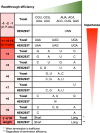Extended stop codon context predicts nonsense codon readthrough efficiency in human cells
- PMID: 38509072
- PMCID: PMC10954755
- DOI: 10.1038/s41467-024-46703-z
Extended stop codon context predicts nonsense codon readthrough efficiency in human cells
Abstract
Protein synthesis terminates when a stop codon enters the ribosome's A-site. Although termination is efficient, stop codon readthrough can occur when a near-cognate tRNA outcompetes release factors during decoding. Seeking to understand readthrough regulation we used a machine learning approach to analyze readthrough efficiency data from published HEK293T ribosome profiling experiments and compared it to comparable yeast experiments. We obtained evidence for the conservation of identities of the stop codon, its context, and 3'-UTR length (when termination is compromised), but not the P-site codon, suggesting a P-site tRNA role in readthrough regulation. Models trained on data from cells treated with the readthrough-promoting drug, G418, accurately predicted readthrough of premature termination codons arising from CFTR nonsense alleles that cause cystic fibrosis. This predictive ability has the potential to aid development of nonsense suppression therapies by predicting a patient's likelihood of improvement in response to drugs given their nonsense mutation sequence context.
© 2024. The Author(s).
Conflict of interest statement
A.J. is co-founder, director, and consultant for PTC Therapeutics Inc. D.B., K.M., L.F., M.D., K.T., and K.K. declare no competing interests.
Figures






Similar articles
-
Cysteine tRNA acts as a stop codon readthrough-inducing tRNA in the human HEK293T cell line.RNA. 2023 Sep;29(9):1379-1387. doi: 10.1261/rna.079688.123. Epub 2023 May 23. RNA. 2023. PMID: 37221013 Free PMC article.
-
Transcriptome-wide investigation of stop codon readthrough in Saccharomyces cerevisiae.PLoS Genet. 2021 Apr 20;17(4):e1009538. doi: 10.1371/journal.pgen.1009538. eCollection 2021 Apr. PLoS Genet. 2021. PMID: 33878104 Free PMC article.
-
Translational readthrough potential of natural termination codons in eucaryotes--The impact of RNA sequence.RNA Biol. 2015;12(9):950-8. doi: 10.1080/15476286.2015.1068497. RNA Biol. 2015. PMID: 26176195 Free PMC article. Review.
-
Pseudouridine-mediated stop codon readthrough in S. cerevisiae is sequence context-independent.RNA. 2020 Sep;26(9):1247-1256. doi: 10.1261/rna.076042.120. Epub 2020 May 20. RNA. 2020. PMID: 32434780 Free PMC article.
-
Molecular Insights into Determinants of Translational Readthrough and Implications for Nonsense Suppression Approaches.Int J Mol Sci. 2020 Dec 11;21(24):9449. doi: 10.3390/ijms21249449. Int J Mol Sci. 2020. PMID: 33322589 Free PMC article. Review.
Cited by
-
Defining the high-translational readthrough stop codon context.PLoS Genet. 2025 Jun 25;21(6):e1011753. doi: 10.1371/journal.pgen.1011753. eCollection 2025 Jun. PLoS Genet. 2025. PMID: 40561183 Free PMC article.
-
Therapeutic Potential of Translational Readthrough at Disease-Associated Premature Termination Codons From Tumor Suppressor Genes.IUBMB Life. 2025 May;77(5):e70018. doi: 10.1002/iub.70018. IUBMB Life. 2025. PMID: 40317855 Free PMC article. Review.
-
The ABCF ATPase New1 resolves translation termination defects associated with specific tRNAArg and tRNALys isoacceptors in the P site.Nucleic Acids Res. 2024 Oct 28;52(19):12005-12020. doi: 10.1093/nar/gkae748. Nucleic Acids Res. 2024. PMID: 39217469 Free PMC article.
-
The ABCF ATPase New1 resolves translation termination defects associated with specific tRNAArg and tRNALys isoacceptors in the P site.bioRxiv [Preprint]. 2024 May 29:2024.05.29.596377. doi: 10.1101/2024.05.29.596377. bioRxiv. 2024. Update in: Nucleic Acids Res. 2024 Oct 28;52(19):12005-12020. doi: 10.1093/nar/gkae748. PMID: 38854126 Free PMC article. Updated. Preprint.
-
Synthetic mRNAs Containing Minimalistic Untranslated Regions Are Highly Functional In Vitro and In Vivo.Cells. 2024 Jul 24;13(15):1242. doi: 10.3390/cells13151242. Cells. 2024. PMID: 39120273 Free PMC article.
References
MeSH terms
Substances
Grants and funding
LinkOut - more resources
Full Text Sources
Other Literature Sources

